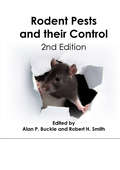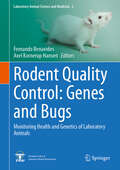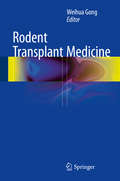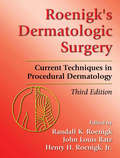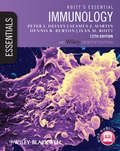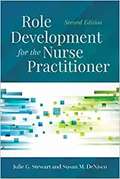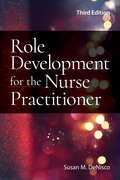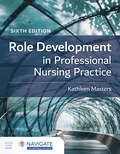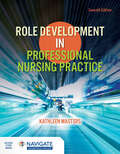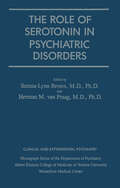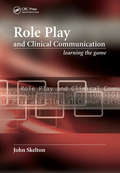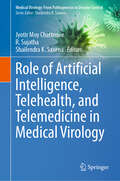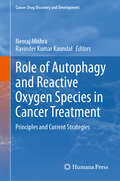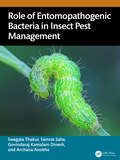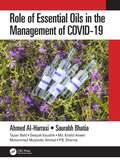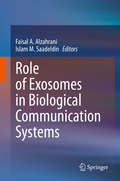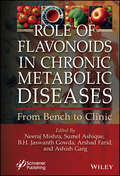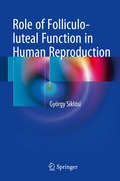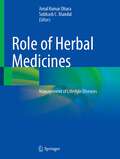- Table View
- List View
Rodent Pests and Their Control
by David Cowan Adrian Meyer Roger Quy Hans-Joachim Pelz David W Macdonald Brian Wood Stephen Battersby Richard Shore Michael Fall Colin Prescott Grant SingletonThe most numerous of the world's invasive species, rodent pests have a devastating impact on agriculture, food, health and the environment. In the last two decades, the science and practice of rodent control has faced new legislation on rodenticides, the pests' increasing resistance to chemical control and the impact on non-target species, bringing a new dimension to this updated 2nd edition and making essential reading for all those involved in rodent pest control, including researchers, conservationists, practitioners and public health specialists.
Rodent Quality Control: Monitoring Health and Genetics of Laboratory Animals (Laboratory Animal Science and Medicine #2)
by Fernando Benavides Axel Kornerup HansenThis book shows how and why quality assurance programmes should be implemented in laboratory rodent facilities to monitor animal health and genetic status. It covers common practice to assure the desired level of microbiological and genetic surveillance of both genetically standardized and genetically altered laboratory mice and rats. In particular, the book introduces readers to the standardized genetic nomenclature and provides step-by-step protocols for genetic monitoring of the animals. International standards of health monitoring programs are discussed and statistical aspects thereof are explored. Furthermore, the book reviews common infectious diseases in laboratory rodents and guides the reader in monitoring the animals’ health status through application of current diagnostic methods. This book adresses researchers, technicians and zookeepers working in laboratory rodent facilities.
Rodent Transplant Medicine
by Weihua GongThis book introduces transplantation in rodents as useful tools used in studying transplant immunobiology. Several solid organs (kidney, heart, liver) transplant models in rodents are described in this book. It can help surgical quality and save surgical time. The first part of the book provides a review of rodent transplant tolerance induction, the role of gender and body-weight in rodent transplantation, surgical instruments and organ preservation solutions. In the second part of the book, various organ-transplantation techniques in rodents are discussed in individual chapters. This book presents uniform surgical procedures in mouse and rats, which produce comparable data, efficiently enhancing the translational research from bench to non-human primates and beyond. It will be of great value to transplant researchers, research fellows and clinicians in many surgical specialties.
Rodent Transplant Medicine
by Weihua GongThis book introduces transplantation in rodents as useful tools used in studying transplant immunobiology. Several solid organs (kidney, heart, liver) transplant models in rodents are described in this book. It can help surgical quality and save surgical time. The first part of the book provides a review of rodent transplant tolerance induction, the role of gender and body-weight in rodent transplantation, surgical instruments and organ preservation solutions. In the second part of the book, various organ-transplantation techniques in rodents are discussed in individual chapters. This book presents uniform surgical procedures in mouse and rats, which produce comparable data, efficiently enhancing the translational research from bench to non-human primates and beyond. In this second edition, authors updates its recent progress. In addition, 3 chapters in mouse organ transplantation are added. It will be of great value to transplant researchers, research fellows and clinicians in many surgical specialties.
Roenigk's Dermatologic Surgery: Current Techniques in Procedural Dermatology
by Martin GardnerThe cornerstone of any dermatologic library, this Third Edition is greatly expanded and revised to provide more than 80 new and updated chapters on topics essential for the surgical dermatologist in day-to-day clinical practice. With outstanding coverage of emerging and established surgical strategies, cosmetic techniques, and reconstruction method
Roitt's Essential Immunology
by Peter J. Delves Seamus J. Martin Dennis R. Burton Ivan M. RoittBMA Book of the Year 2012 First prize in Basic and Clinical Sciences, BMA Book Awards 2012 Roitt's Essential Immunology - the textbook of choice for students and instructors of immunology worldwide Bringing you fully up-to-date with the latest knowledge and concepts about the workings of the immune system, the hallmark easy-reading style of Roitt's Essential Immunology clearly explains the key principles needed by medical and health sciences students, from the basis of immunity to clinical applications. Beautifully presented, with brand new illustrations, the pedagogy has been strengthened throughout, and includes "just to recap. . . " sections at the beginning of each chapter, reminding the reader of key findings and principles, and summary sections at the end of each chapter that are ideal for quick study and revision. Also available as a FREE enhanced Wiley Desktop Edition (upon purchase of the book), Roitt's Essential Immunology is supported by a suite of online resources at www. roitt. com including: Interactive MCQs and SBA questions for each chapter, with feedback on all answers selected Animations and videos showing key concepts Fully downloadable figures and illustrations, further reading and useful links Extracts from the Encyclopaedia of Life Science Podcasts to reinforce the key principles explained in the text: ideal for revision 'on the go'
Roitt's Essential Immunology (Essentials #20)
by Peter J. Delves Seamus J. Martin Dennis R. Burton Ivan M. RoittBMA Book of the Year 2012 First prize in Basic and Clinical Sciences, BMA Book Awards 2012 Roitt's Essential Immunology - the textbook of choice for students and instructors of immunology worldwide Bringing you fully up-to-date with the latest knowledge and concepts about the workings of the immune system, the hallmark easy-reading style of Roitt's Essential Immunology clearly explains the key principles needed by medical and health sciences students, from the basis of immunity to clinical applications. Beautifully presented, with brand new illustrations, the pedagogy has been strengthened throughout, and includes “just to recap…” sections at the beginning of each chapter, reminding the reader of key findings and principles, and summary sections at the end of each chapter that are ideal for quick study and revision. Also available as a FREE enhanced Wiley Desktop Edition (upon purchase of the book), Roitt's Essential Immunology is supported by a suite of online resources at www.roitt.com including: Interactive MCQs and SBA questions for each chapter, with feedback on all answers selected Animations and videos showing key concepts Fully downloadable figures and illustrations, further reading and useful links Extracts from the Encyclopaedia of Life Science Podcasts to reinforce the key principles explained in the text: ideal for revision 'on the go' This title is also available as a mobile App from MedHand Mobile Libraries. Buy it now from iTunes, Google Play or the MedHand Store.
Role Development For The Nurse Practitioner
by Julie G. Stewart Susan M. DeNiscoRole Development for the Nurse Practitioner, Second Edition is an integral text that guides students in their transition from the role of registered nurse to nurse practitioner. The text provides a comprehensive framework for interactive discussions on the role of the nurse practitioner, giving students a full understanding of the skills and knowledge needed for this dynamic profession. The text employs a variety of nurse practitioner real-world stories to illustrate important points and to assist in the transition from RN to NP. Through in-depth coverage of the concepts and skills critical to the nurse practitioner, the authors provide a strong foundation for the role, exploring topics such as nurse practitionering as a unique practice theory. Key Features: Seminar questions at the end of each chapter Nurse practitioner stories Alignment to Masters and DNP Essentials Instructor Resources Syllabus Transition guide Case studies Discussion questions Test bank PowerPoint slides Instructor's manual
Role Development for the Nurse Practitioner
by Susan M. DeNiscoRole Development for the Nurse Practitioner, Third Edition is an integral text that guides students in their transition from the role of registered nurse to nurse practitioner.
Role Development in Professional Nursing Practice
by Kathleen MastersRole Development in Professional Nursing Practice, Sixth Edition, is comprehensive resource to guide students along their journey as professional nurses.
Role Development in Professional Nursing Practice
by Kathleen MastersRole Development in Professional Nursing Practice continues to serve as a clear and concise road map for pre-licensure nursing students on their journey to becoming a professional nurse. Well-written and engaging, Kathy Masters starts with the foundational concepts that help professional nurses thrive and seamlessly progresses into issues directly related to patient-centered care, including quality and safety, evidence-based practice, leadership, teamwork and collaboration, and ethical and legal issues. Through theory, classroom activities, case studies, and engaging learning resources, Role Development in Professional Nursing Practice, Seventh Edition provides students with the knowledge and competencies that they need for a successful nursing career.
Role Emerging Occupational Therapy: Maximising Occupation-Focused Practice
by Matthew Molineux Sue Baptiste Mary Edwards Miranda ThewRole Emerging Occupational Therapy: Maximising Occupation Focused Practice is written for an audience of occupational therapy practitioners, educators and students. This text offers an exploration of emerging innovative directions for the profession of occupational therapy with a focus upon the theory and application of role emerging placements. The book affords the reader an opportunity to explore how occupation focused practice can be applied to a wide variety of settings and circumstances in order to improve the health and well-being of a diverse range of people. Chapters cover relevant theory as well as offering practical guidance with examples drawn from the experiences of university educators, occupational therapists, setting/service providers and students. The book describes, explores and discusses both the potential and ramifications of role emerging practice on the occupational therapy profession and offers a vision for the future of the profession that reflects current occupational, social and health needs.
Role Of Serotonin In Psychiatric Disorders
by Serena-Lynn BrownThis is No 4 of a monograph's on Clinical and Experimental Psychiatry, which aims to keep track of important developments in Psychiatry, to summarize what has been achieved in particular fields and to bring together the view points obtained from disparate vantage points- to capture some of the excitement ongoing in modern psychiatry both in its clinical and experimental dimensions. This edition looks the role of Serotonin in Clinical Psychiatric Research.
Role Play and Clinical Communication: Learning the Game
by John Skelton Anneliese Guerin-LeTendreIn "Role Play and Clinical Communication", John Skelton critically considers the practice and benefits of this mainstream teaching method. His wide-ranging approach reflects on the recent developments within medical education, incorporating the medical humanities, the nature of language and communication, and the rules of human behaviour. You will find Skelton's light-hearted and open-minded attitude to communication unquestionably illuminating.
Role of Artificial Intelligence, Telehealth, and Telemedicine in Medical Virology (Medical Virology: From Pathogenesis to Disease Control)
by R. Sujatha Jyotir Moy Chatterjee Shailendra K. SaxenaThe book explores the intersection of AI, telehealth, and viral infections, discussing the role of AI in pandemics, telehealth services, viral diagnosis, and antiviral drug development. It explores the integration of AI into telehealth, predicting outbreaks and monitoring mutations. The book emphasizes patient-centric healthcare, highlighting AI's transformative potential in infectious diseases. It covers medical virology, bioinformatics, machine learning, and neural networks. AI enables streamlined workflows, improved patient care, and new research methodologies. It addresses challenges and tailored solutions for AI integration in telehealth. It serves as a valuable resource for clinicians, physicians, virologists, researchers, and healthcare professionals seeking to navigate the evolving landscape of telehealth and harness the full potential of AI in transforming healthcare delivery.
Role of Autophagy and Reactive Oxygen Species in Cancer Treatment: Principles and Current Strategies (Cancer Drug Discovery and Development)
by Neeraj Mishra Ravinder Kumar KaundalAutophagy is a catabolic process that eliminates damaged and faulty cellular components via lysosomes. It responds to adverse circumstances like nutritional deficiency, hypoxia, and oxidative damage. Reactive oxygen species (ROS) cause oxidative stress, which is a multidimensional chemical that drives various pathophysiological diseases, including cancer. In addition, the autophagy process has a double role, first preventing tumour formation, but later fostering tumour progression. A growing body of research suggests that autophagy and ROS have a complex interplay in which they can either prevent cancer growth or enhance disease genesis. While a combination of autophagy inhibitor and cytotoxic medicines is now being used in cancer treatment, investigating the potential of autophagy inhibitors for overcoming resistance to different anticancer medications and how this relates to the control of cancer micro environmental stressors raises several questions. Autophagy's dual functions as a safeguarding and cytotoxic process have drawn attention to its significance in the development of cancer.
Role of Birds in Transmitting Zoonotic Pathogens (Livestock Diseases and Management)
by Yashpal Singh Malik Arockiasamy Arun Prince Milton Sandeep Ghatak Souvik GhoshZoonotic diseases pose a serious threat to global health and economy. Domestic and wild birds play crucial roles in transmission and spread of important zoonotic pathogens, with significant implications on human and avian health. Although zoonotic diseases have been extensively studied, information on various aspects of avian zoonotic pathogens have not been revisited or revised to any great extent. This book is a comprehensive and updated compilation of important zoonotic diseases that are transmitted by domestic and wild birds, and consists of 21 chapters that meticulously describe the (i) etiology and evolution, (ii) complex epidemiology, such as migration pathways in context of disease transmission, (iii) pathogenesis, (iv) clinical signs and necropsy findings, (v) diagnostics including latest molecular assays, and (vi) preventative and control strategies, with an emphasis on therapeutics and prophylaxis, of important zoonotic pathogens (bacterial, fungal, parasitic and viral) of avian origin in humans and birds. Each chapter is aptly supported by interactive tables and figures, and features an updated reference section. This book aims to create awareness and enlighten students of veterinary and human medicine on the role of birds in zoonoses, and would serve as a useful reference for working veterinarians, human doctors, and public health experts.
Role of Capsaicin in Oxidative Stress and Cancer
by Sanjay K. SrivastavaThis book describes the mechanism of the anti-cancer effects of capsaicin including the involvement of cytochrome P-450 in the bioactivation; identification of mitochondria as the key target site for oxidative stress; involvement of mitochondrial respiratory chain in the production of ROS; prevention of chemically-induced carcinogenesis, discussion on TRPV-1 receptor mediated or independent anti-cancer effects; identification of p53 activation as a possible mechanism; involvement of Cox-2 in apoptosis, suppression of transcription factors such as NF-kB and STAT-3; inhibition of cell survival pathways including PI3K/Akt and the involvement of intrinsic mitochondrial cell death pathway.
Role of Entomopathogenic Bacteria in Insect Pest Management
by Swagata Thakur Samrat Saha Govindaraj Kamalam Dinesh Archana AnokheThis book highlights the important contribution of entomopathogenic bacteria in transforming the management of insect pests. It meticulously details their mechanisms, historical development, and crucial role in integrated pest management (IPM) strategies. With a focus on sustainable and environmentally friendly pest control, the book categorizes and explains various entomopathogenic bacteria, providing insights into their mode of action, advantages, and disadvantages. It also compiles essential information about insecticidal toxins produced by these bacteria and their historical context, spanning over a century of research. Additionally, the book sheds light on ongoing research, including genetic engineering, mutualistic relationships, and resistance management. Through its holistic approach, this book underscores the significance of entomopathogenic bacteria in achieving the UN Sustainable Development Goals and various ecosystem services. It offers a vital perspective on their ecological, economic, and policy implications, making it important for those seeking sustainable solutions in agriculture and pest management. This book is intended for professionals and researchers in the fields of entomology, agriculture, and pest management.
Role of Essential Oils in the Management of COVID-19
by Saurabh Bhatia Ajay Sharma Ahmed Al-Harrasi Tapan Behl Deepak Kaushik Md. Khalid Anwer Mohammed Muqtader Ahmed Pritam Babu Sharma Md. Tanvir Kabir Vineet MittalCoronavirus disease 2019 (COVID-19) has emerged as a global health threat. Unfortunately, there are very limited approved therapeutics available with established efficacy and safety profiles against SARS-CoV-2. COVID-19 vaccines aim to actively induce systemic immunization; however, the possibility or fear of side effects decreases or discourages their use. Alternative therapy via natural products, especially essential oils, could be considered safe and effective to improve health, cure ailments, and soothe your body and mind. Essential oils, which have been known for their anti-inflammatory, immunomodulatory, bronchodilatory, and antiviral properties, could possibly be useful for the symptomatic management of COVID-19. This book is vital in respect of designing approaches to protect humanity from further losses and harm due to SARS-CoV-2 infection. Role of Essential Oils in the Management of COVID-19 offers a complete outline of the recent novel coronavirus (SARS-CoV-2) infection, its biology, and associated challenges for the prevention and treatment of novel COVID-19, with a prime focus on the possible role of essential oils in the prevention and treatment of COVID-19. This book is written for everyone who needs to be thoroughly familiar with the appropriate and safe use of essential oils in COVID-19 therapy. As per the objectives of the book: The first seven chapters cover various aspects of COVID-19 infection, including epidemiology, origin, morphology, genome organization, pathogenesis, clinical manifestations, diagnostic approaches, preventive measures, and treatment strategies. The remaining chapters elaborate on the various aspects related to essential oils, such as chemistry, extraction methods, dispensing methods, stability, quality control, mechanism of action, therapeutic effects, pharmacokinetics, aromatherapy, and safety profiles. Prof. Ahmed Al-Harrasi is Vice Chancellor for Graduate Studies, Research and External Relations, Natural and Medical Sciences Research Center, and Professor of Organic Chemistry, University of Nizwa, Oman. Prof. Ahmed received his M.Sc. degree in Chemistry followed by his Ph.D. in Organic Chemistry from the University of Berlin. He then pursued his postdoctoral research at Cornell University. Afterward, he continued his research rigor at the University of Nizwa, where he founded the Natural and Medical Sciences Research Center, which has now become a center of excellence in natural and medical sciences. While enduring his research aptitude, he has authored and co-authored more than 400 scientific papers, 2 books, and 12 book chapters of high repute. Dr. Saurabh Bhatia graduated from Kurukshetra University, followed by postgraduation from Bharati Vidyapeeth University. He received his Ph.D in Pharmaceutical Technology at Jadavpur University. He now works as an Associate Professor at Natural and Medical Sciences Research Center, University of Nizwa, Oman. He has 12 years of academic experience; has authored 75 articles and 9 books of repute; and filed 11 patents.
Role of Exosomes in Biological Communication Systems
by Faisal A. Alzahrani Islam M. SaadeldinThis book reviews the role of exosomes and extracellular vesicles in both normal and pathological conditions. It first explains isolation methods for exosomes, and analyzes their fine structure and biological functions. Further, it highlights exosomes’ role as the key regulator in embryonic-maternal communication, and in the pathogenesis of various diseases, including cancer and urogenital, infectious, and neurodegenerative diseases. Moreover, it reviews the latest advances in using stem-cell-derived exosomes as a cell-free strategy in regenerative medicine, as well as the potential of exosomal microRNA as a promising non-invasive biomarker and targetable factor in cancer diagnosis and treatment. Lastly, it explores the use of natural and synthetic exosomes as nano-vehicles for efficient drug delivery.
Role of Flavonoids in Chronic Metabolic Diseases: From Bench to Clinic
by Neeraj Mishra Sumel Ashique Ashish Garg Arshad Farid B.H. Jaswanth GowdaThis comprehensive volume covers the entire field of flavonoids by explaining their complex functions in reducing chronic metabolic illnesses, from the early stages of laboratory research to the development of therapeutic uses. Flavonoids are plant-based substances proven to have potential medical benefits in managing chronic metabolic disorders. This book explores concepts in laboratory research and therapeutic capabilities to enhance awareness of flavonoids in a medical context. The book begins with a thorough examination of the basic biochemical and molecular processes that underlie long-term metabolic disorders. It looks into these bioactive substances, from their natural origins to the synthesis of innovative derivatives. Analyzing both lab research and preclinical trials critically, it provides a solid basis for understanding the exciting opportunities flavonoids bring in treating metabolic diseases. The scope of this work extends beyond theoretical domains into clinical environments. It closes the gap between bench-side findings and bedside applications by revealing the translational potential of flavonoids. It is possible to understand the practical implications and future directions of flavonoid-based therapeutics through the synthesis of evidence-based clinical studies, therapeutic approaches, and possible healthcare issues. Readers will find the book: contains cutting-edge insights into metabolic disease research and delves into recent discoveries on the molecular mechanisms of flavonoids; facilitates a viewpoint into the findings of practical clinical implementations and the progression of flavonoid investigations from controlled experimental environments to prospective therapeutic interventions; explores the scientific effects of flavonoids on chronic metabolic disorders; presents evidence from human trials and epidemiological research on flavonoid clinical processes; encompasses various aspects of preventive measures for managing widespread metabolic diseases, containing dietary recommendations, lifestyle interventions, and the potential involvement of flavonoids; offers a comprehensive guide on how to effectively utilize flavonoids for therapeutic purposes. Audience This book is intended for researchers, scientists, clinicians/physicians, and public health professionals who work in pharmacology settings. The book is a vital tool for clinicians, nutritionists, and other healthcare professionals who are concerned about cutting-edge methods for dietary guidelines to gain an understanding of flavonoids and long-term metabolic disorders.
Role of Folliculo-luteal Function in Human Reproduction
by György SiklósiThis book is the first to explain fully the crucial role of folliculo-luteal function in recurrent miscarriage, unexplained infertility, preterm birth, intrauterine growth retardation, preeclampsia, random chromosomal abnormalities, and age-related reproductive disorders. In addition it describes treatments to avoid these conditions and proposes a novel method, "hormonal wedge resection", that can successfully cure infertility associated with polycystic ovary syndrome. Importantly, the conclusions drawn in this book are based on the therapeutic results observed in a representative patient population. The method developed by the author to quantitatively diagnose the hormonal insufficiency of ovulatory cycles (folliculo-luteal insufficiency, FLI) has made it possible to recognize the formerly unclear importance of this function in human reproduction. Folliculo-luteal function determines the conditions of placentation and thus the features of the developed placenta and the outcome of pregnancy. Different grades of FLI are associated with consequences of varying severity that can be prevented by normalization of folliculo-luteal function prior to conception. This book will be required reading for all obstetricians and gynecologists.
Role of Gut Microbiota and Postbiotics for Colorectal Cancer: Advancing Therapeutic Strategies (Cancer Drug Discovery and Development)
by Neeraj Mishra Sumel Ashique Ashish GargThe emerging role of gut microbiota and postbiotics has implications for the management of not only human health and diseases, but also colorectal cancer in particular, as these elements influence colorectal cancer pathogenesis, treatment, and prevention. This book bridges the gap between cutting-edge research and practical clinical applications in the management of colorectal cancer by offering a fresh perspective on potential therapeutic strategies and exploring the significance of microbiota in the oncology landscape. Chapters delve into the specific impacts of postbiotics, linking them to immune response modulation, inflammation reduction, and direct anticancer effects. Chapters also explore current and emerging therapies, including the manipulation of gut microbiota and the use of postbiotics supplements. Clinical trial results, case studies, and expert opinions are interwoven to present a realistic view of the benefits, limitations, and future prospects of these innovative therapeutic strategies. This book is rounded out with perspectives on future research directions in this area, discussing potential next-generation therapies such as personalized medicine approaches and biotechnological advancements, and further contemplating broader implications of microbiota research on public health strategies. Informative and engaging, this book provides clinicians and researchers alike with a deeper understanding of how postbiotics can be harnessed in colorectal cancer treatment and potentially, the treatment of other cancers influenced by gut health.
Role of Herbal Medicines: Management of Lifestyle Diseases
by Subhash C. Mandal Amal Kumar DharaEmergence of lifestyle diseases, e.g., type II diabetes, cancers, obesity, cardiovascular disorders, liver cirrhosis, etc., are exponentially increasing day by day. Modern drifts toward the utilization of herbal medicines in different healthcare aspects necessitate (demand) the replacement of synthetic molecules with phytoconstituents because of their biocompatibility, biodegradability, economic extraction process, and ready availability from the natural source. This book provides a thorough insight into the comprehensive and up-to-date trends of phytomedicines in the management of lifestyle diseases and its mechanisms, modern methods of extraction and purification of phytoconstituents, and chemical characterization as well as standardization of phytoconstituents using modern equipments.
